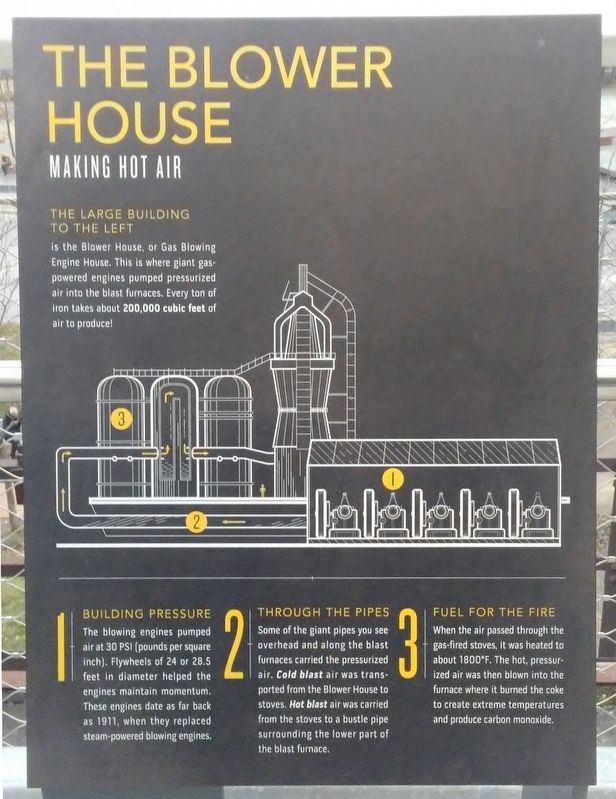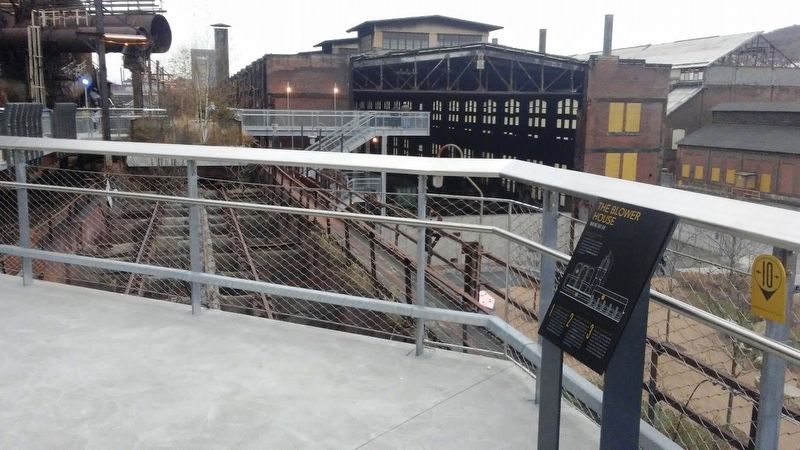The Blower House
Making Hot Air
The large building to the left is the Blower House. This is where giant gas-powered engines pumped pressurized air into the blast furnaces. Every ton of iron takes about 200,000 cubic feet of air to produce!
1 Building Pressure
The blowing engines pumped air at 30 PSI (pounds per square inch). Flywheels of 24 or 28.5 feet in diameter helped the engines maintain momentum. These engines date as far back as 1911, when they replaced steam-powered blowing engines.
2 Through The Pipes
Some of the giant pipes you see overhead and along the blast furnaces carried the pressurized air. Cold blast air was transported from the Blower House to stoves. Hot blast air was carried from the stoves to a bustle pipe surrounding the lower part of the blast furnace.
3 Fuel For The Fire
When the air passed through the gas-fired stoves, it was heated to about 1800°F. The hot, pressurized air was then blown into the furnace where it burned the coke to create extreme temperatures and produce carbon monoxide.
Erected by SteelStacks. (Marker Number 10.)
Topics. This historical marker is listed in these topic lists: Industry & Commerce • Man-Made Features. A significant historical year for this entry is 1911.
Location.
Other nearby markers. At least 8 other markers are within walking distance of this marker. Bethlehem Built (a few steps from this marker); The Bethlehem Beam (within shouting distance of this marker); A Community of Workers (within shouting distance of this marker); Hot, Loud, & Dangerous (within shouting distance of this marker); A Legacy of Steel (within shouting distance of this marker); One Of The Hardest Jobs In The World (within shouting distance of this marker); Making Iron (within shouting distance of this marker); Air Products (about 300 feet away, measured in a direct line). Touch for a list and map of all markers in Bethlehem.
Also see . . .
1. Bethlehem Steel: Forging America. (Submitted on February 6, 2018, by William Fischer, Jr. of Scranton, Pennsylvania.)
2. Bethlehem Steel Corporation. (Submitted on February 6, 2018, by William Fischer, Jr. of Scranton, Pennsylvania.)
3. How it works: The Blast Furnace. (Submitted on February 6, 2018, by William Fischer, Jr. of Scranton, Pennsylvania.)
4. Blast Furnace: The Making of Iron with Animations and Diagrams (YouTube). (Submitted on February 6, 2018, by William Fischer, Jr. of Scranton, Pennsylvania.)
5. The New Blast Furnace of the Bethlehem Steel Company - I (Landis, 1910). (Submitted on February 6, 2018, by William Fischer, Jr. of Scranton, Pennsylvania.)
6. What is SteelStacks?. (Submitted on February 6, 2018, by William Fischer, Jr. of Scranton, Pennsylvania.)
Credits. This page was last revised on February 6, 2018. It was originally submitted on February 6, 2018, by William Fischer, Jr. of Scranton, Pennsylvania. This page has been viewed 674 times since then and 92 times this year. Photos: 1, 2, 3. submitted on February 6, 2018, by William Fischer, Jr. of Scranton, Pennsylvania.


